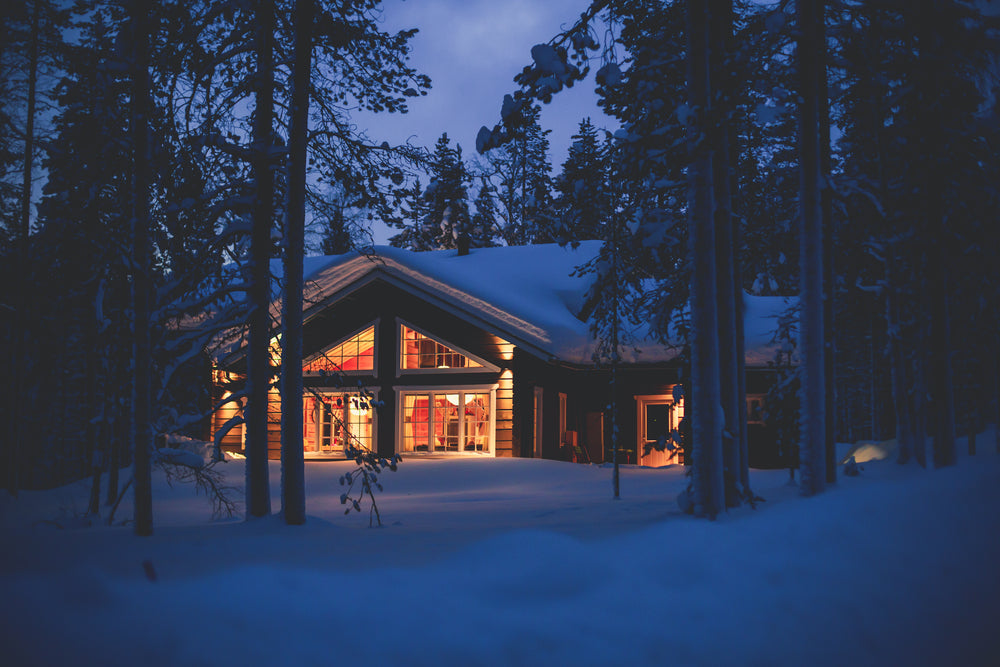Insulating a Log Cabin & Other Energy Saving Tactics

Are log cabins energy-efficient? The short answer is, “not really.” Even after logs are waterproofed and treated, they don’t provide a lot of insulation to help save energy. Thankfully, multiple tactics can help you save money on heating, cooling, and electricity.
How to insulate a log cabin
First, let’s talk about the r-value of wood. R-value is a material’s relative insulative value. Most types of wood don’t offer high amounts of insulation. Log cabin walls have a rough r-value of 8, less than the recommended minimum for exterior walls (r-value 13). Although log walls gather heat during the day and release it throughout the night, this thermal retention isn’t sufficient for heating in climates with large temperature swings. That said, a multifaceted approach is necessary when insulating a log cabin.
Insulating cabin walls
Because wood doesn’t have adequate insulation, you’ll want to take extra steps to ensure your cabin is energy efficient. One of the best ways to insulate a log cabin is injector foam insulation. This type of insulation fills the gap between the logs of your house and the drywall. However, if you’re trying for a more rustic and all-natural look without drywall, we suggest using open-cell foam for insulating. Compared to other types of insulation, open cell foam expands more and will ensure a solid seal between the logs and where the walls meet the floor and roof.
Insulating the roof & floors
We also recommend using barricade wall paneling to insulate your cabin roof. These panels are typically used when insulating basement walls and are composed of wafer board glued to 2 inches of insulated foam. You can use this same type of insulation on your floors – which is highly advisable in cabins without the added floor insulation from a basement. Furthermore, decorating your floors with large area rugs helps keep your feet warm and stops warmth from escaping through the floorboards.
Extra insulation tips
You can further seal your cabin by spraying foam insulation underneath sinks, around electrical boxes, and between joints on air ducts. Foam insulation tubes can be installed around your water pipes if you want to get professional when sealing your cabin. Additionally, for extra heat retention you can look into installing triple-pained or storm windows on your exterior walls. Even if your cabin windows are insulated, curtains and window treatments can offer added protection against the cold and keep cool air in during summer.
In winter, save on heating and make your living spaces cozier by decorating with layered quilts, duvets, and throw blankets. The best way to warm up on a chilly evening is with a cup of hot cocoa wrapped in a quilt. Also, you can create the perfect winter lodge aesthetic with rustic winter bedding.
Using less electricity
Let's talk about electrical savings now that we know how to properly insulate our log cabins. Besides insulation, you can save on your cabin’s electrical bill with easy-to-install devices. Ceiling fans, energy-saving lights, and even power strips can help you save more on energy.
Ceiling fans
A ceiling fan can cool you down in the summer and costs nearly one hundred times less than air conditioning. Although fans won’t be able to provide complete comfort in hotter months, using them in tandem with AC helps save on energy costs. Also, you can do this without sacrificing the old-fashioned feel of your log cabin by using rustic ceiling fans.
Lighting
Installing multiple light fixtures with energy-efficient LED bulbs is another great way to cut your cabin energy bill. This way, you can choose the right amount and placement of light – using only the light you need saves money. Moreover, if you have a fireplace, you can use it to illuminate the living room and stay warmer in winter. Simply close it up when you’re not using it to prevent heat loss.
For more information on lighting your log cabin, click here.
Modern cabin electrical savings
Just because your lodge has a rustic look doesn’t mean it can’t have modern components. Consider using supplementary heat sources like space heaters or propane furnaces if your log home is in a colder climate. According to the US Department of Energy, using propane to heat your home is much more cost-effective than using electricity. Other modern energy-saving devices that are easy to install include:
- Light timers - installing timers on your light fixtures is a good way to make sure you don’t accidentally leave lights on when not in use. You can also get motion sensors for lights to automate your energy savings.
- Smart thermostats - a smart thermostat can automatically adjust your cabin temperature, using a conservative amount of energy for heating or air conditioning.
- Bluetooth power strips - plugged-in electrical devices consistently use small amounts of electricity even when not turned on. Curtail energy consumption by plugging electrical devices into a Bluetooth, remote-controlled power strip and turning them off when not in use.
Decorating your cabin with energy savings
An energy-efficient log cabin is beneficial when renting out your lodge to guests. The tactics above can help your cabin save energy and provide a more comfortable stay. Better yet, you can find decor that helps with energy efficiency while completing a rustic look. Cabin Place stocks cooling ceiling fans, high-quality lighting fixtures, and insulating window treatments that add to the natural allure of a wilderness retreat. Shop our online store for charming, rustic, and functional decor for your chalet today!










